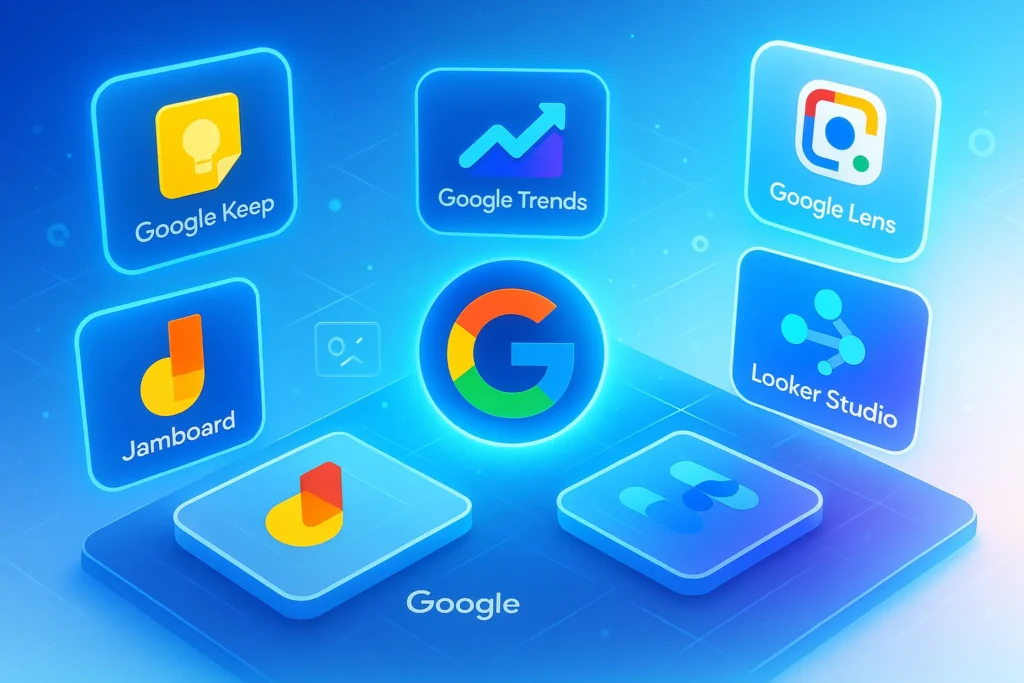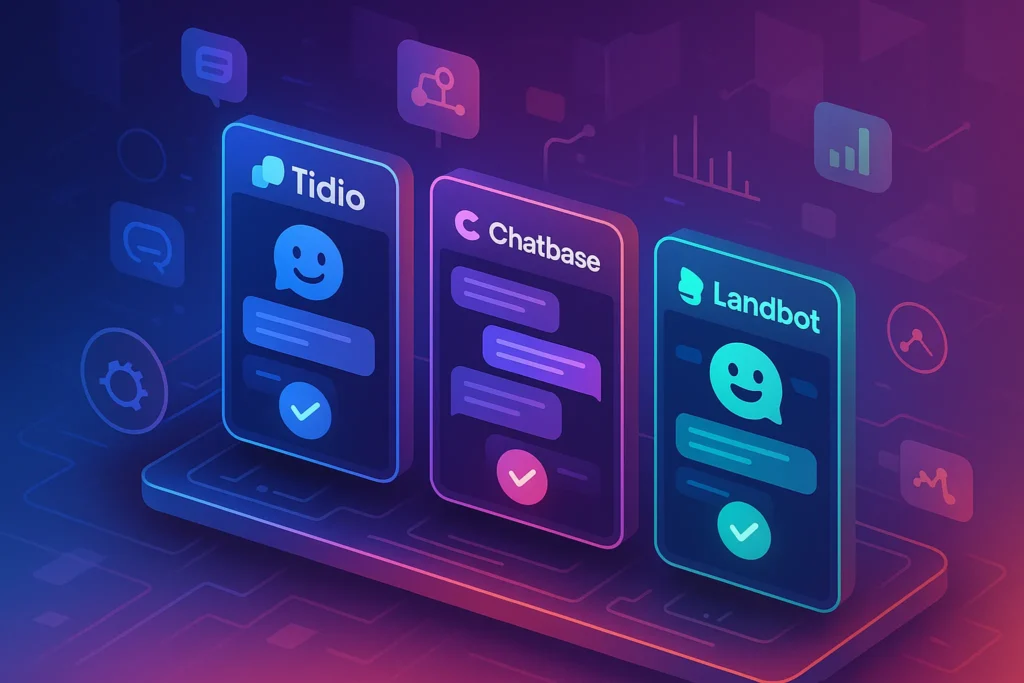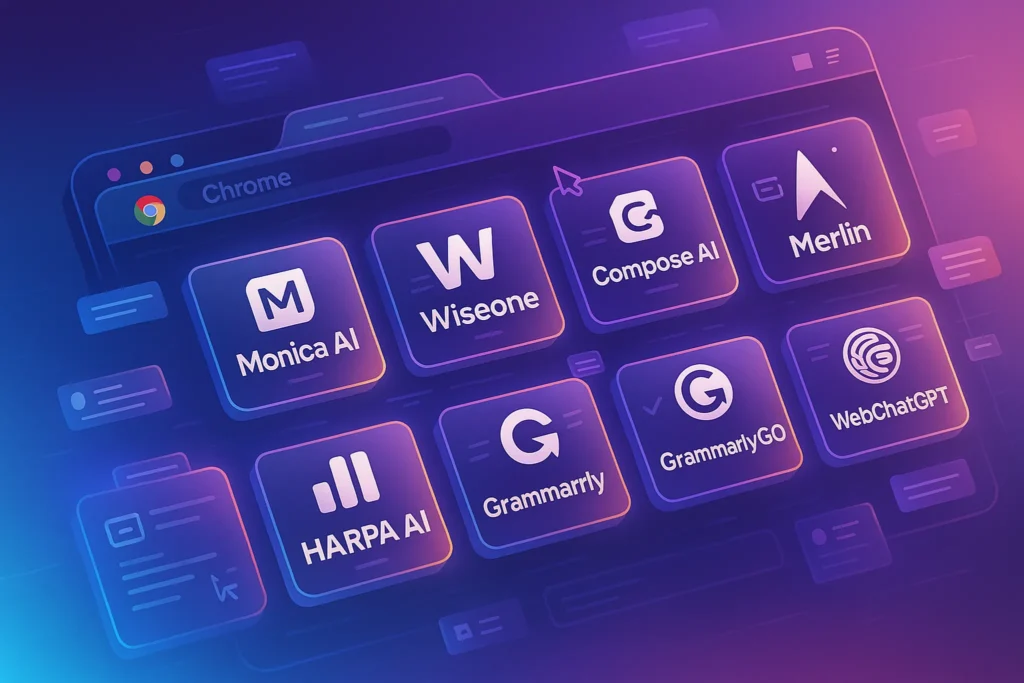-This post may contain affiliate links. If you click on one and make a purchase, I may earn a small commission at no extra cost to you.-
🧠 Introduction: Google Beyond Gmail
You already use Gmail, Google Maps, and YouTube daily. But did you know Google has a suite of lesser-known tools that can seriously level up your productivity, research, and content creation—for free?
These aren’t just “bonus” tools. They’re real workflow boosters that thousands of creators, marketers, students, and researchers use daily (quietly). In this post, we’re uncovering the most underrated Google tools and showing you how to actually use them.
💬 “You don’t need more apps—you need better use of what you already have.”
🗒️ 1. Google Keep – Notes That Actually Sync With Your Brain
Google Keep isn’t just a sticky-note app—it’s a cross-platform capture system with underrated power. You can label your notes, collaborate in real time, and set location-based reminders (e.g., remind me to call John when I get to the office). Notes are instantly searchable, and the Chrome extension lets you clip content from websites and save it directly to Keep.
A lightweight note-taking app that works seamlessly across devices. Pin tasks, color-code ideas, add checklists, and voice-record thoughts. It also integrates with Google Docs and Calendar.
💼 Real Use Case:
A content strategist uses Google Keep to jot article ideas and instantly pull them into Docs via the side panel while drafting.
A productivity-focused student uses Keep to tag notes by subject (“Biochem”, “Assignments”) and syncs them with their Google Calendar study blocks.
🔄 Want more ways to streamline your writing process? We broke down some amazing add-ons in our guide to Google Docs AI Extensions—a must-read for writers.
📊 2. Google Trends – See What the World is Searching
What makes Google Trends incredibly powerful isn’t just the keyword graphs—it’s the Related Queries and Breakout Topics section. This is where SEO-savvy marketers discover emerging micro-niches before they explode. You can also filter by category, country, and type (image, YouTube, news) to fine-tune your research.
Want to validate a blog topic, compare brand interest, or spot rising opportunities? Google Trends is your free keyword radar with region-based and historical data.
🧠 Pro Workflow:
A blogger targeting affiliate products checks Trends monthly to spot new keyword angles (e.g., “eco-friendly office setup” in Q2 2025), then builds content around high-rising search phrases.
-
Explore seasonal spikes
-
Compare interest over time (e.g., “Notion vs Evernote”)
-
Track rising queries in your niche
💼 Real Use Case:
An ecommerce owner uses it weekly to choose content ideas and seasonal sales campaigns.
🧠 Nerd Tip: Trends data also helps with YouTube titles and hashtag planning.
🔍 3. Google Lens – Visual Search, Solved
Few people realize Google Lens can now scan handwritten notes, instantly turn them into digital text, and let you send that text straight to Google Docs or Keep. It also supports smart shopping—just point at an item (e.g., a shoe, book, laptop) and it will find product listings, price comparisons, and even visual matches across the web.
Point your phone camera at anything—text, object, product—and get live info. Google Lens reads text, translates signs, identifies products, and even copies handwriting into your clipboard.
🧠 Use-Case Layering:
A remote content creator uses Lens to scan mind maps or whiteboards after brainstorming sessions and convert them to digital text for team sharing.
💼 Real Use Case:
A digital nomad uses Lens to scan restaurant menus abroad, translate text instantly, and even copy handwritten notes to Google Docs.
⚙️ Bonus: Combine this with OCR plugins for Chrome to build a powerful visual content workflow. We covered more like this in Top Chrome Extensions.
📂 4. Google Jamboard – Your Free Online Whiteboard
While Jamboard was initially built for education, it’s quickly become a go-to tool for remote brainstorming and visual project planning. You can drop in sticky notes, draw arrows, embed images, or write freehand on touchscreens. Best of all, every board auto-saves in Google Drive, making it easy to revisit later or convert to presentation slides.
An interactive whiteboard app that works perfectly for brainstorming sessions, online classes, and remote team meetings. Think digital sticky notes, freeform diagrams, and real-time collaboration.
🧠 Example Scenario:
A UX designer uses Jamboard during client workshops to co-create wireframes with non-technical stakeholders, building rapport and ideas live.
💼 Real Use Case:
A startup founder maps weekly sprint plans on Jamboard and shares them directly via Meet with remote developers.
🔄 Replace tools like Miro or Lucidchart—unless you need enterprise features.
📈 5. Google Data Studio (Looker Studio) – Free Dashboard Power
Beyond the basics, Data Studio (now Looker Studio) allows blending multiple data sources into one dashboard. For example, you can create a unified KPI board that pulls traffic data from GA4, sales from a Google Sheet, and email opens from Mailchimp—all in real time.
It also supports dynamic filters, dropdowns, and time comparisons, making it perfect for client reporting dashboards or solopreneur analytics.
Create dynamic, interactive dashboards pulling data from Google Sheets, Analytics, YouTube, or Search Console. It’s perfect for marketers, creators, and agencies needing visual reports—without paying for Tableau.
🧠 Use Case Layering:
A marketing agency sends each client a live Data Studio link instead of monthly PDF reports, reducing manual effort and impressing clients with up-to-date metrics.
💼 Real Use Case:
A YouTube creator builds a dashboard showing watch time trends + top-performing videos using Data Studio + YouTube Analytics API.
📊 If organizing dashboards, content, and personal KPIs matters to you, check out our full post on Organize Your Digital Life for more real-world systems.
📚 6. Google Dataset Search – A Goldmine for Research
Google Dataset Search isn’t just for researchers—it’s a practical tool for bloggers, journalists, startup founders, and even YouTube creators. It indexes datasets across universities, government bodies, international organizations (like WHO, IMF), and research institutions.
It supports filtering by last updated, data format, and usage rights, making it easy to find free-to-use datasets without legal concerns.
If you do any kind of data-driven work—blog posts, academic research, or startup ideation—Dataset Search is your hidden superpower. It indexes millions of datasets from governments, institutions, and publishers.
You can use it to find:
-
CSV or Excel datasets on consumer trends
-
Open-source financial reports
-
Climate data for visual storytelling
-
Historical stats for comparative analysis
🧠 Use-Case Layering:
A fintech blogger finds quarterly consumer spending data for Europe from OECD via Dataset Search, turning raw numbers into charts and insights in a viral article.
💼 Real Use Case:
A newsletter writer uses Dataset Search to pull real-world statistics on AI job trends, adding authority and trust to their content.
💡 Nerd Tip: Filter by update date, license type, or topic. It’s like Google Scholar—but for raw data.
📨 7. Google Alerts – Free Reputation + Trend Monitoring
Beyond simple keyword monitoring, Google Alerts is a secret weapon for reputation management, trend tracking, content curation, and even competitor spying. You can create alerts like:
-
"yourbrand.com" -site:yourbrand.com(to track external mentions) -
"AI productivity tools" + review(for new blog content in your niche) -
"competitor name" + interview OR podcast(to learn positioning)
It’s also a powerful content discovery engine. Many marketers use Alerts to find fresh blog/news content around their topic, then summarize or respond to it on their own platform.
Track mentions of your name, business, competitor, or keyword via Google Alerts. It’s like a personal assistant for online monitoring—delivered via email.
🧠 First-Person Insight:
“I use Google Alerts to get notified when a new SaaS product in the AI space launches, so I can be among the first to write a comparative review or trend roundup.”
💼 Real Use Case:
A freelancer sets alerts for “[client name] + press” and gets notified anytime their client is mentioned online.
⚠️ Set alerts for your domain name and key industry trends to never miss an opportunity—or a threat.
🎭 8. Google Arts & Culture – A Creative Playground
This beautifully designed platform is a treasure chest for anyone working in design, education, or content. You can:
-
Do deep dives into artist timelines or movements
-
Take interactive quizzes that teach visual literacy
-
Use the “Art Selfie” feature to find your art twin
-
Virtually visit famous landmarks, temples, or museums
But here’s where it gets creative: The “Color Palette” tool lets you upload any image and find artworks that match your color theme—perfect for designers looking for color inspiration with cultural depth.
While not “productive” in the traditional sense, this tool is a hidden gem for creatives and educators. Explore virtual museum tours, high-res artwork, culture quizzes, and color palette extractors.
💼 Real Use Case:
A graphic designer uses the “Art Palette” tool to extract colors from Van Gogh paintings and apply them to a client website redesign.
A brand strategist pulls palettes from 18th-century Japanese prints via Arts & Culture, then uses those hues in a minimalist landing page for a meditation app.
🎨 Format Variation Layer – Creativity Snapshot
“In 2 minutes, I had 5 color themes inspired by Monet, not Pinterest.”
🌍 9. Google Earth – Research + Storytelling
Google Earth isn’t just a globe you spin—it’s an immersive geo-storytelling platform. Through the “Projects” feature, you can add pins, write descriptions, embed images or video, and create entire story-based maps.
It’s ideal for:
-
Visual trip itineraries
-
Environmental impact presentations
-
Historical timelines across geography
-
Business expansion maps for reports or fundraising decks
And for creators? You can record interactive video tours or embed live maps into blog posts.
Google Earth isn’t just for looking at maps. You can now create your own “stories” with pinpoints, text, video, and paths—great for presentations, virtual tours, or even content planning.
💼 Real Use Case:
A travel content creator builds interactive maps with notes, links, and embedded videos to share destinations visually on their blog.
A sustainability YouTuber creates a Google Earth project showing glacial retreat over time, with before-after photos embedded at each location. The visual impact turns a simple narrative into something powerful.
🧠 Nerd Verdict
Google’s hidden tool ecosystem isn’t hidden because it’s weak—it’s hidden because people stop at Gmail and Drive.
From data visualization and idea capture to search monitoring and design inspiration, these tools are genuinely powerful—and completely free. No subscriptions. No credit cards. No marketing gimmicks.
And when used together? They can replace multiple paid apps in your workflow.
❓ FAQ: Nerds Ask, We Answer
Yes. Every tool mentioned is currently free to use without limitations or trials. Some offer pro-level functionality at zero cost.
Many like Google Keep, Docs (with setup), and Jamboard offer offline modes. Others like Data Studio and Trends are online-only.
Yes, they’re built by Google and backed by enterprise-grade security. Always adjust your privacy settings as needed.
💬 Would You Bite?
Which Google tool surprised you the most—or which one are you using already like a power user?
Drop your go-to tool in the comments—and share this post with someone still stuck on just Gmail and Drive. 👇



